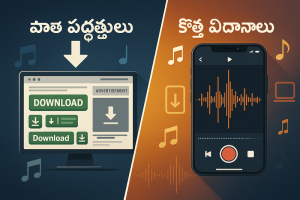Ever stumbled upon an incredible song snippet or podcast clip on Twitter that you desperately wanted to save for offline listening?
You’re not alone—millions of music enthusiasts and content creators face this exact challenge daily. While Twitter has become a treasure trove of audio content, from exclusive music previews to viral sound bites, the platform doesn’t offer a direct way to extract audio from videos.
Whether you’re a music producer hunting for inspiration, a content creator building your audio library, or simply someone who loves collecting unique sounds, converting Twitter videos to MP3 has become an essential skill in today’s digital landscape.
The good news? There are several reliable methods to help you capture that perfect audio clip, and I’m here to walk you through each one.
In This Article:
Why Twitter Audio Extraction Matters More Than Ever
Let’s be real here—Twitter has evolved into something way beyond just text updates. Musicians drop exclusive snippets, podcasters share golden moments, and viral sounds spread like wildfire. But here’s the kicker: all this amazing audio content is locked inside video files that you can’t easily save or use elsewhere.
I’ve been there myself. Found this incredible jazz sample in a random Twitter video, spent hours trying to figure out how to extract it properly. That’s when I realized most people are struggling with the same thing.
Real-World Use Cases That Hit Home
Music Discovery and Collection Trust me, Twitter is where you’ll find those hidden gems before they blow up on Spotify. Artists often tease new tracks, share studio sessions, or post acoustic versions that never make it to streaming platforms.
Content Creation Gold Mine If you’re creating videos, podcasts, or social media content, Twitter is packed with sound effects, voice clips, and background music that can elevate your projects. Just remember to respect copyright laws.
Educational and Podcast Clips Found an amazing explanation in a Twitter video? Converting it to MP3 means you can listen during commutes or add it to your learning playlist.
Understanding the Legal Side (Because Nobody Wants Trouble)
Before we dive into the how-to stuff, let’s talk about the elephant in the room—copyright. Here’s what you need to know:
Personal Use vs. Distribution Converting Twitter videos for your personal listening? Generally okay. Sharing or selling that content? That’s where things get tricky. Always respect the original creator’s rights.
Public vs. Private Content Stick to public tweets and avoid downloading from private accounts without permission. It’s just good digital citizenship.
Quick Legal Tip: When in doubt, reach out to the content creator. Most are happy to share if you ask nicely and explain your intended use.
Method 1: The Professional Route with Cinch Audio Recorder
After testing dozens of tools, I keep coming back to Cinch Audio Recorder for one simple reason—it just works. No fuss, no quality loss, and it handles everything from Twitter to Spotify recording seamlessly.
Why Cinch Stands Out From the Crowd
High-Quality Recording (320kbps MP3 or Lossless WAV) Unlike online converters that compress your audio into oblivion, Cinch captures everything at the source quality. If the Twitter video has good audio, you’ll get good audio.
Automatic ID3 Tag Magic This feature alone saves me hours. Cinch automatically detects and adds song information, artist names, and even album artwork when available. No more manually organizing your downloads.
Silent Recording Mode Here’s something cool—you can record without any sound coming through your speakers. Perfect for late-night sessions or when you’re in a quiet environment like a library.
Built-in Audio Editor Need to trim that clip or create a ringtone? Cinch has you covered with basic editing tools that handle most common tasks.
Step-by-Step: Recording Twitter Audio with Cinch
Step 1: Get Cinch Set Up Download and install Cinch Audio Recorder. The setup is straightforward—just follow the prompts and you’re ready to go.
Step 2: Configure Your Recording Settings Open Cinch and click the “Record” tab. The default settings work great for most situations, but you can adjust quality if needed. I usually stick with 320kbps MP3 for the perfect balance of quality and file size.
Step 3: Start Recording and Play Your Twitter Video Hit the red Record button in Cinch, then play your Twitter video. Cinch will automatically capture the audio as it plays through your system.
Step 4: Stop and Save When the video ends, stop the recording. Cinch will process the audio and save it with proper metadata. You can find your files in the Library tab or by right-clicking and selecting “Open File Location.”
Pro Tips for Better Results
Volume Matters Keep your system volume at a reasonable level. Too low and you’ll get weak audio; too high might cause distortion.
Close Unnecessary Apps Minimize background noise by closing other applications that might make sounds during recording.
Use the Filter Feature If you’re recording from free Spotify or other platforms with ads, Cinch’s filter feature can automatically remove those annoying interruptions.
Method 2: Quick Online Solutions for Casual Use
Sometimes you just need a quick conversion without installing software. Online tools can be handy for occasional use, though they come with trade-offs.
Popular Online Converters Breakdown
| Tool | Quality | Speed | Ads | File Size Limit | Best For |
|---|---|---|---|---|---|
| twdown.net | Good | Fast | Minimal | 100MB | Quick conversions |
| SSSTwitter | Variable | Medium | Some | 50MB | Batch downloads |
| SaveTwitter | Good | Slow | Many | 200MB | High-res videos |
| CloudConvert | Excellent | Fast | Few | 1GB | Quality priority |
twdown.net: The Straightforward Choice This one’s pretty reliable for basic conversions. Copy your Twitter video URL, paste it in, select MP3, and download. The interface is clean, and it usually preserves decent quality.
CloudConvert: When Quality Matters If you need the best possible quality from an online tool, CloudConvert is worth trying. It supports multiple formats and maintains better audio fidelity than most competitors.
How to Use Online Converters
Step 1: Copy the Twitter Video URL Right-click on the Twitter video and select “Copy video address” or use the share button to copy the tweet link.
Step 2: Paste and Convert Go to your chosen converter, paste the URL, select MP3 format, and hit convert.
Step 3: Download Your File Once processing is complete, download the MP3 file to your device.
Reality Check: Online converters are convenient but often compress audio quality. For important clips or regular use, professional software like Cinch delivers better results.
Method 3: Browser Extensions for One-Click Convenience
Browser extensions offer a middle ground between online tools and desktop software. They’re convenient but limited in features.
Chrome Audio Capture Extension
This extension integrates directly into your browser, making it easy to capture audio from any tab.
Installation and Setup
- Go to the Chrome Web Store
- Search for “Chrome Audio Capture”
- Click “Add to Chrome”
- Pin the extension to your toolbar
Using the Extension
- Navigate to your Twitter video
- Click the extension icon
- Start recording and play the video
- Stop recording when done
- Save the captured audio
Limitations to Consider
- Quality depends on browser audio processing
- No automatic metadata tagging
- Limited editing capabilities
- May not work with all video types
Comparison: Which Method Should You Choose?
Let me break this down based on different user needs:
For Regular Users Who Want Quality
Recommendation: Cinch Audio Recorder
- Best audio quality preservation
- Automatic metadata handling
- Built-in editing tools
- One-time purchase, no ongoing costs
For Occasional Quick Conversions
Recommendation: Online converters (twdown.net or CloudConvert)
- No installation required
- Free to use
- Good for testing
For Browser-Heavy Users
Recommendation: Chrome Audio Capture
- Integrated workflow
- No separate app switching
- Quick access from any tab
Quality Optimization: Getting the Best Audio
Here’s what I’ve learned about maximizing audio quality through trial and error:
Source Quality is Everything
You can’t improve what isn’t there. A low-quality Twitter video will produce low-quality audio regardless of your conversion method. Look for videos with clear audio and minimal background noise.
Recording Environment Tips
- Use headphones to monitor audio levels
- Record in a quiet environment to avoid picking up external sounds
Post-Processing Basics
Even with good recording software, a little post-processing can help:
- Normalize audio levels for consistent volume
- Remove silence from the beginning and end
- Apply light noise reduction if needed
Tools like Audacity (free) or the built-in editor in Cinch can handle basic cleanup tasks. For more advanced audio editing techniques, check out our guide on how to clean audio with Audacity.
Troubleshooting Common Issues
“The Audio Sounds Distorted” Usually caused by recording levels that are too high. Lower your system volume and try again.
“No Audio is Being Captured” Check your audio input/output settings. Make sure the recording software is set to capture system audio, not microphone input.
“The Conversion Failed” This often happens with private videos or content that has playback restrictions. Stick to public content and ensure you have permission to download.
Advanced Tips for Power Users
Creating Custom Ringtones
Cinch includes a ringtone maker that’s perfect for turning Twitter audio clips into custom phone alerts. The tool automatically suggests the best 30-second segments and formats them correctly for iOS and Android.
Organizing Your Audio Library
Develop a consistent naming convention for your downloaded files. I use: “Artist – Title – Source (Twitter)” format. This makes everything searchable later. If you’re working with music files, you might also want to learn about adding ID3 tags to MP3 files for better organization.
The Bottom Line: What Actually Works
After testing everything from sketchy online converters to premium software, here’s my honest take:
For most people, Cinch Audio Recorder hits the sweet spot. It’s reliable, produces high-quality results, and includes features that save time in the long run. The $25.99 price tag might seem steep compared to “free” online tools, but it’s worth it.
Online converters work for occasional use but don’t expect miracles. They’re fine for testing or quick conversions.
Browser extensions are convenient but limited. They’re best for users who rarely convert audio.
Frequently Asked Questions
Q: Is it legal to convert Twitter videos to MP3?
A: Converting public Twitter videos for personal use is generally acceptable, but always respect copyright laws and avoid distributing copyrighted content.
Q: What’s the best quality I can achieve?
A: With professional tools like Cinch Audio Recorder, you can achieve 320kbps MP3 or lossless WAV quality, depending on the source video quality.
Q: Which method is fastest for multiple videos?
A: Professional software with batch processing capabilities offers the most efficient solution.
Q: Do online converters affect audio quality?
A: Yes, many online converters compress audio further, reducing quality compared to professional recording software.
The world of Twitter audio is constantly evolving. Having reliable tools and methods for capturing this content ensures you won’t miss out on those perfect audio moments.
Whether you choose the professional route with Cinch or stick with quick online solutions, the key is finding a method that fits your needs and respects content creators’ rights.












